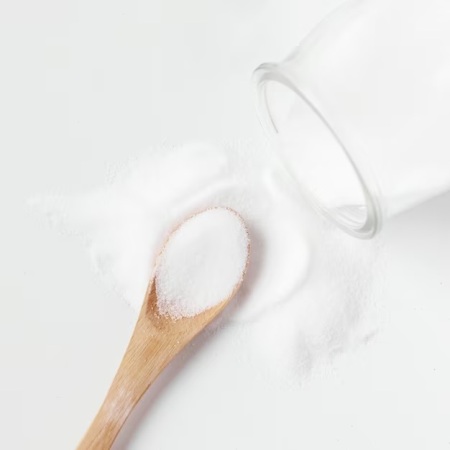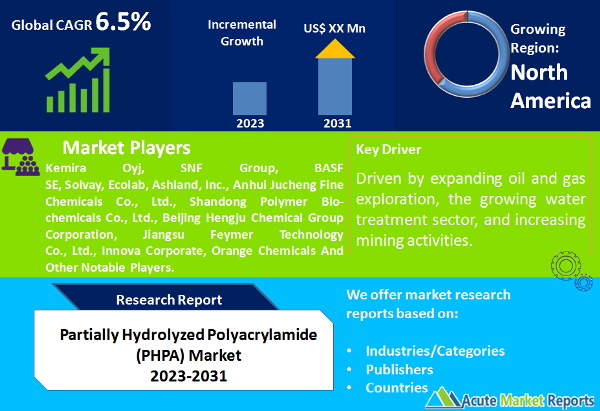
The partially hydrolyzed polyacrylamide (PHPA) market is a vital component of the chemical industry, with widespread applications in various sectors. The partially hydrolyzed polyacrylamide (PHPA) market is expected to grow at a CAGR of 6.5% during the forecast period of 2025 to 2033, driven by expanding oil and gas exploration, the growing water treatment sector, and increasing mining activities. The restraint of environmental concerns underscores the need for responsible practices and regulatory compliance. Market segmentation by type and function provides insights into specific areas of growth within the market, and geographic trends reflect the importance of regional variations in demand. Competitive players are expected to continue their emphasis on innovation, sustainability, and global expansion to meet the evolving needs of diverse industries relying on PHPA.

Expanding Oil and Gas Exploration
The significant driver for the PHPA market is the expanding oil and gas exploration activities worldwide. PHPA is extensively used in drilling fluids for oil and gas wells. It functions as a viscosifying agent and shale stabilizer, enhancing drilling efficiency and preventing wellbore instability. With the rising global demand for energy, oil and gas exploration and production have surged, necessitating the increased use of PHPA in drilling operations.
Growing Water Treatment Sector
The growing water treatment sector is another major driver for the PHPA market. PHPA is employed as a flocculation agent in water and wastewater treatment processes. It aids in the removal of suspended solids and pollutants, contributing to the purification of water for various applications, including municipal water treatment and industrial processes. The increasing concerns regarding water quality and the need for effective treatment solutions have driven the demand for PHPA in the water treatment industry.
Expanding Mining Activities
The expanding mining activities worldwide contribute significantly to the demand for PHPA. In mining operations, PHPA is utilized as a flocculation agent and an excapsulator, aiding in solid-liquid separation and the removal of impurities. The mining industry's continuous growth, driven by the demand for minerals and resources, has led to increased usage of PHPA in various mining processes.
Restraint in the PHPA Market
A notable restraint in the partially hydrolyzed polyacrylamide market is the environmental concerns associated with its production and usage. The synthesis of PHPA involves the use of acrylamide, a chemical known to be a potential neurotoxin and carcinogen. While PHPA itself is non-toxic and safe when used in recommended concentrations, concerns arise regarding the potential presence of residual acrylamide in PHPA products. Additionally, the environmental impact of acrylamide production and disposal of used PHPA products poses challenges for the industry, necessitating stringent regulations and responsible practices.
Market Segmentation by Type (Anionic, Cationic, Non-ionic, Others): Anionic Segment Dominates the Market
The PHPA market can be segmented by type into four categories: anionic, cationic, non-ionic, and others. In 2024, the "anionic" type generated the highest revenue, reflecting its widespread use in various applications, including oil and gas drilling, water treatment, and mining. For the period from 2025 to 2033, the "cationic" type is expected to exhibit the highest compound annual growth rate (CAGR). The cationic PHPA's ability to effectively flocculate and separate particles in water and wastewater treatment processes is anticipated to drive its growth.
Market Segmentation by Function (Viscosifying Agent, Shale & Bore-hole Stabilizer, Excapsulator, Flocculation Agent, Others): Viscosifying Agent Dominates the Market
The PHPA market can be segmented by function into five categories: viscosifying agent, shale & bore-hole stabilizer, excapsulator, flocculation agent, and others. In 2024, the "viscosifying agent" function witnessed the highest revenue, emphasizing the crucial role of PHPA in enhancing the viscosity of drilling fluids, especially in oil and gas exploration. For the period from 2025 to 2033, the "flocculation agent" function is expected to experience the highest CAGR. The demand for efficient water and wastewater treatment solutions is projected to drive the growth of PHPA as a flocculation agent.
North America Remains the Global Leader
The PHPA market exhibits geographic variations in demand and growth. Geographic trends indicate that regions with substantial oil and gas reserves, water treatment needs, and mining activities tend to lead in PHPA consumption. North America, with its well-established oil and gas industry and stringent water quality regulations, has been a prominent market for PHPA. When considering the region with the highest CAGR during the forecast period from 2025 to 2033, the Asia-Pacific region is expected to exhibit substantial growth. The region's rapid industrialization and urbanization have amplified the demand for PHPA in diverse applications. In terms of revenue percentage, North America is expected to maintain its position as the region with the highest revenue percentage throughout the forecast period. The region's mature industries and regulatory requirements contribute to its prominence in the PHPA market.
Market Competition to Intensify during the Forecast Period
The PHPA market features several key players, including Kemira Oyj, SNF Group, BASF SE, Solvay, Ecolab, Ashland, Inc., Anhui Jucheng Fine Chemicals Co., Ltd., Shandong Polymer Bio-chemicals Co., Ltd., Beijing Hengju Chemical Group Corporation, Jiangsu Feymer Technology Co., Ltd., Innova Corporate, and Orange Chemicals. These companies employ specific strategies to maintain and expand their market presence. In 2024, Kemira Oyj held a significant market share, offering a wide range of PHPA products catering to various industrial applications. The company's strategy focused on research and development, emphasizing the development of eco-friendly PHPA formulations and sustainable production processes. SNF Group, a global leader in water-soluble polymers, excelled in providing PHPA products for water and wastewater treatment. Their strategy emphasized global expansion, with a focus on emerging markets with growing water treatment needs. BASF SE, a prominent chemical company, positioned itself as a key player in the market. Their strategy centered on innovation, with a focus on developing PHPA products tailored to the unique requirements of the oil and gas, mining, and water treatment sectors. For the forecast period from 2025 to 2033, these companies are expected to continue their strategies, focusing on sustainability, innovation, and expanding their product portfolios. They will explore new technologies and applications to meet the evolving demands of the PHPA market.
Historical & Forecast Period
This study report represents analysis of each segment from 2023 to 2033 considering 2024 as the base year. Compounded Annual Growth Rate (CAGR) for each of the respective segments estimated for the forecast period of 2025 to 2033.
The current report comprises of quantitative market estimations for each micro market for every geographical region and qualitative market analysis such as micro and macro environment analysis, market trends, competitive intelligence, segment analysis, porters five force model, top winning strategies, top investment markets, emerging trends and technological analysis, case studies, strategic conclusions and recommendations and other key market insights.
Research Methodology
The complete research study was conducted in three phases, namely: secondary research, primary research, and expert panel review. key data point that enables the estimation of Partially Hydrolyzed Polyacrylamide (PHPA) market are as follows:
Market forecast was performed through proprietary software that analyzes various qualitative and quantitative factors. Growth rate and CAGR were estimated through intensive secondary and primary research. Data triangulation across various data points provides accuracy across various analyzed market segments in the report. Application of both top down and bottom-up approach for validation of market estimation assures logical, methodical and mathematical consistency of the quantitative data.
| ATTRIBUTE | DETAILS |
|---|---|
| Research Period | 2023-2033 |
| Base Year | 2024 |
| Forecast Period | 2025-2033 |
| Historical Year | 2023 |
| Unit | USD Million |
| Segmentation | |
Type
| |
Function
| |
Application
| |
End-Use
| |
|
Region Segment (2023-2033; US$ Million)
|
Key questions answered in this report